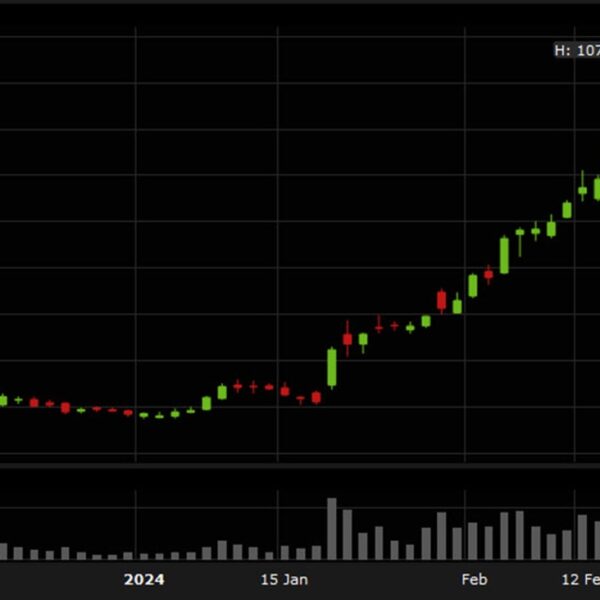If you’re looking to start a new career, there’s good news: there are countless occupations that are expected to rapidly expand over the next decade—and many come with six-figure salaries.
Wind turbine service technicians, solar photovoltaic installers, nurse practitioners, data scientists, and information security analysts are expected to be the fastest growing occupations, according to the U.S. Bureau of Labor Statistics’s most recent projections of 2023–2033 released last month. All five of these roles are expected to grow at least by 33%—which is significantly higher than the average for all jobs, 4%. Moreover, they also all pay median salaries higher than the average for all occupations, which sits at $48,000.
Advertisement
STEM-designated. Tar Heel ROI. No compromises.
UNC Kenan-Flagler’s top-ranked online MBA is a top choice for experienced professionals with strong undergraduate performance. You can earn your degree at your own pace—in 18 to 36 months—without sacrificing academic quality and rigor. Access lifelong career benefits and join a global community of over 44,000 alumni with an AACSB-accredited online MBA from UNC-Chapel Hill. Online MBA Fellowships Available. GMAT waivers available. Learn more today.


The 10 fastest growing jobs
| Occupation | Growth rate, 2023–33 | 2023 Median annual pay |
|---|---|---|
| Wind turbine service technicians | 60% | $61,700 |
| Solar photovoltaic installers | 48% | $48,800 |
| Nurse practitioners | 46% | $126,260 |
| Data scientists | 36% | $108,020 |
| Information security analysts | 33% | $120,360 |
| Medical and health services managers | 29% | $110,680 |
| Physician assistants | 28% | $130,020 |
| Computer and information research scientists | 26% | $145,080 |
| Physical therapist assistants | 25% | $64,080 |
| Operations research analysts | 23% | $83,640 |
| The 10 occupations with the most new jobs | ||
|---|---|---|
| Wind turbine service technicians | ||
| 60% | ||
| $61,700 | ||
| Solar photovoltaic installers | ||
| 48% | ||
| $48,800 | ||
| Nurse practitioners | ||
| 46% | ||
| $126,260 | ||
| Data scientists | ||
| 36% | ||
| $108,020 | ||
| Information security analysts | ||
| 33% | ||
| $120,360 | ||
| Medical and health services managers | ||
| 29% | ||
| $110,680 | ||
| Physician assistants | ||
| 28% | ||
| $130,020 | ||
| Computer and information research scientists | ||
| 26% | ||
| $145,080 | ||
| Physical therapist assistants | ||
| 25% | ||
| $64,080 | ||
| Operations research analysts | ||
| 23% | ||
| $83,640 | ||
The 10 fastest growing jobs
All data according to the BLS.
Wind turbine service technicians
- Growth rate: 60%
- New jobs: 6,800
- Median annual pay: $61,770
- Education required: No degree required, but additional training needed
Solar photovoltaic installers
- Growth rate: 48%
- New jobs: 12,000
- Median annual pay: $48,800
- Education required: No degree required, but additional training needed.
Nurse practitioner
- Growth rate: 46%
- New jobs: 135,500
- Median annual pay: $126,260
- Education required: Master’s degree
Learn more: Read our guide on how to become an advanced nurse practitioner and check out our ranking of the best online MSN nurse practitioner programs.
Data scientists
- Growth rate: 36%
- New jobs: 73,100
- Median annual pay: $108,020
- Education required: Bachelor’s degree
Learn more: Read our guides on how to become a data scientist, how to become a data analyst, and our ranking of the best online master’s in data science.
Information security analysts
- Growth rate: 33%
- New jobs: 59,100
- Median annual pay: $120,360
- Education required: Bachelor’s degree
Learn more: Check out our resources on how to become a cybersecurity specialist, how to get into cybersecurity without a degree, and our ranking of the best online master’s in cybersecurity.
Medical and health services managers
- Growth rate: 29%
- New jobs: 160,600
- Median annual pay: $110,680
- Education required: Bachelor’s degree
Physician assistants
- Growth rate: 28%
- New jobs: 43,700
- Median annual pay: $130,020
- Education required: Master’s degree
Computer and information research scientists
- Growth rate: 26%
- New jobs: 9,400
- Median annual pay: $145,080
- Education required: Master’s degree
Learn more: Check out our resources on how to become a software engineer as well as our ranking of the best in-person master’s in computer science and best online master’s in computer science.
Physical therapy assistants
- Growth rate: 25%
- New jobs: 27,500
- Median annual pay: $64,080
- Education required: Associate’s degree
Operational research analysts
- Growth rate: 23%
- New jobs: 28,300
- Median annual pay: $83,640
- Education required: Bachelor’s degree
The 10 fastest declining occupations
- Word processor and typists (-38%)
- Roof bolters, mining (-32%)
- Telephone operations (-26.4%)
- Switchboard operators, including answer service (-25.2%)
- Data entry keyers (-25.0%)
- Foundry mold and coremakers (-24.6%)
- Loading and moving machine operations, underground mining (-22.9%)
- Pattern makers, metal and plastic (-22.2%)
- Telemarketers (-21.5%)
- Engine and other machine assemblers (-21.3%)
A booming number of new jobs
With the U.S. projected to add 6.7 million new jobs by 2033, Michael Wolf, division chief for employment projections at BLS, says some of the biggest takeaways occupation-wise also centers around the number of jobs. In the healthcare field alone, for example, millions of new jobs are projected to be created.
The biggest growing occupation is home health & personal care aids—which is expected to need over 820,500 more workers. Registered nurses, medical & health services managers, and nurse practitioners are also each expected to grow by hundreds of thousands of jobs.
The 10 occupations with the most projected new jobs
| Occupation | Number of projected new jobs, 2023-33 | 2023 Median annual pay |
|---|---|---|
| Home health and personal care aids | 820,500 | $33,530 |
| Software developers | 303,700 | $132,270 |
| Cooks, restaurant | 244,500 | $35,780 |
| Fast food and counter workers | 212,500 | $29,540 |
| General and operations managers | 210,400 | $101,280 |
| Registered nurses | 197,200 | $86,070 |
| Stockers and order fillers | 168,600 | $36,390 |
| Medical and health services managers | 160,600 | $110,680 |
| Financial managers | 138,300 | $156,100 |
| Nurse practitioners | 135,500 | $126,260 |
| The 10 occupations with the most new jobs | ||
|---|---|---|
| Home health and personal care aids | ||
| 820,500 | ||
| $33,530 | ||
| Software developers | ||
| 303,700 | ||
| $132,270 | ||
| Cooks, restaurant | ||
| 244,500 | ||
| $35,780 | ||
| Fast food and counter workers | ||
| 212,500 | ||
| $29,540 | ||
| General and operations managers | ||
| 210,400 | ||
| $101,280 | ||
| Registered nurses | ||
| 197,200 | ||
| $86,070 | ||
| Stockers and order fillers | ||
| 168,600 | ||
| $36,390 | ||
| Medical and health services managers | ||
| 160,600 | ||
| $110,680 | ||
| Financial managers | ||
| 138,300 | ||
| $156,100 | ||
| Nurse practitioners | ||
| 135,500 | ||
| $126,260 | ||
The salaries of these roles, Wolf says, often correlates to the level of education required.
“We find occupations that require a college degree are growing faster. Bachelor’s degree occupations are growing on average 7.2% over the projection period—that’s compared with 4% for all jobs,” Wolf notes.
Occupations requiring master’s degrees are growing even faster—at a rate of 12.1%, but interestingly enough, the median wage of those with a master’s degree, $79,840, is lower than those with just a bachelor’s degree. Part of this is because managerial occupations are classified as just requiring a bachelor’s degree, Wolf says.
“Managers tend to have basically more work experience, which is boosting their pay, as opposed to having the pay be solely based on education—so that’s boosting bachelor’s degree a little bit,” Wolf explains. He adds that some professions requiring master’s degrees, such as social workers or counselors, have relatively low wages as compared to their education level.
The takeaway: the job market is constantly evolving
Technology has historically played a major role in shaping the occupations of the U.S., and it will continue into the future. AI and other developments have certainly more recently made many roles more efficient and may have contributed to the declines in some roles like clerical workers. However, at the same time, innovation has created opportunities in other areas that are seeing rapid growth like data science and cybersecurity.
Ultimately, Wolf hopes people use BLS data to explore occupations—but not necessarily let it determine one’s destiny.
“You don’t want to make your decisions to say, I’m just going to choose the fastest growing occupation or the highest paying one. I think it has to align with your interests and your skills and ability. But you should take the growth and you should take the wage into account,” Wolf explains.
He adds that there’s an “probably an occupation that fits well for everyone,”—they just have to find one that fits.
Frequently asked questions
What career field is growing the fastest?
The healthcare field is experiencing some of the fastest growth, with occupations like home health & personal care aides, registered nurses, medical & health services managers, and nurse practitioners all seeing significant growth.
What job is in highest demand?
Home health and personal care aides are expected to grow the most in terms of number of jobs over the next decade, with an expected increase of over 800,000. Software engineers—which pay over $100,000 more—are the second-most in demand, with an increase of over 325,000 jobs.
What are the fastest growing jobs in 2024?
In terms of growth rate, wind turbine service technicians, solar photovoltaic installers, nurse practitioners, data scientists, and information security analysts are expected to be the fastest growing occupations over the next decade.
Check out all of Fortune’s rankings of degree programs, and learn more about specific career paths.















